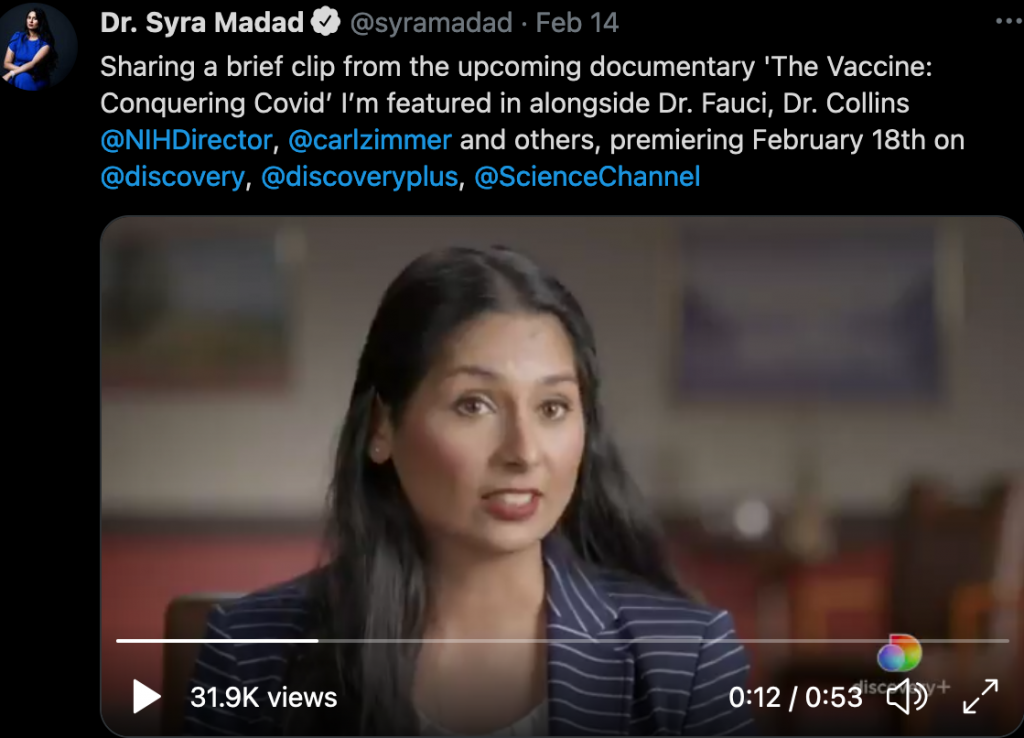Dr Syra Madad always knew a major pandemic was on its way. What she didn’t expect was an outbreak of misinformation and mistrust.
Dr Syra Madad remembers watching the movie Outbreak, enthralled by watching Dustin Hoffman and Rene Russo play doctors seeking a cure for a deadly, Ebola-like pandemic. Madad told her parents this would be her future career. “I was interested not just in infectious disease, but in highly infectious diseases,” she told The Brilliant.
Today Madad is the senior director of New York City’s (NYC) Health and Hospitals System-wide Special Pathogens Program, and a key figure in managing NYC’s response to infectious diseases like measles, Ebola—and Covid-19.
Which arrived out of the blue in 2020.
The unlearned lessons of Ebola
Madad was on the team that identified the first Ebola case in the USA back in 2014. She paid a price for that work—she and her colleagues found themselves ostracised, even by other health professionals. “My dentist cancelled my routine teeth cleaning,” she says. “I had colleagues that were part of the New York City Ebola response who were uninvited from birthday parties.”
More importantly, the experience taught her that the US wasn’t properly prepared for a major disease outbreak. In December 2019, Madad and Ron Klain, the Obama administration’s Ebola response coordinator, published an op-ed in Washington Post, warning that the “day will come when a dangerous pathogen will arrive in the United States once again”. They urged the government to keep funding a major program that equipped the over 6,000 hospitals in the USA with facilities and training for a pandemic. In January 2020, Madad also appeared in the Netflix documentary Pandemic: How to Prevent an Outbreak. “The next pandemic is going to start,” she said. “We just don’t know where or how, but we know it will.”
Just weeks later, that prediction came true. Unfortunately, the USA was missing the “one voice” approach from government, which puts health experts front and centre to educate the public on preventative measures and address misconceptions.
In the beginning, the message from the government was ‘go ahead and live your life. Do whatever you want. Open up the states. Covid is not a threat’,” she says. “And that’s where that one voice of science fell through the cracks.”
The two pillars
Madad says that science communication rests on two major pillars. “It’s the message and the messenger. When we talk about the messenger, we need to have the people who are credible in this field, and who can articulate the information in terms people can understand.” Communicators also need to be empathetic, active listeners who can answer questions with facts. “Where we went wrong early on is that our messengers were politicians who had no idea what they were talking about,” she says.
The second communication pillar is the message itself. “It needs to be culturally competent, match the health literacy of your audience and be bite-sized. If you tell people 30 minutes of information, they are going to understand the first two and last two minutes.”
Madad says that in a time where the public can access information instantly, it’s vital that health professionals are the first to provide information, even if it means admitting that there are unknowns. “If we don’t, they will get information from somewhere else, even if it is false,” she says.
Madad says that because the Trump administration spread a lot of falsehoods, American epidemiologists, doctors and other healthcare experts became popular on social media. “We had to fill the gap,” she says. “There are a lot of people that want to hear from scientists.”
When it comes to reporting, Madad believes the media needs to find specialists, rather than interview doctors who lack relevant experience. “You can’t expect an emergency doctor to talk about contact tracing when that’s not what they do,” she points out.
A pandemic unfolds
At the end of February 2020, the first American died of Covid-19 and it became clear that the predicted pandemic had arrived. Madad found herself in the spotlight—something she wasn’t prepared for.
I teach, I talk about what I do, but the media is very different,” she says, adding she had to grow a thick skin at top speed. What she hadn’t expected was the number of people who were sceptical about science and public health. “I was used to people understanding what I’m saying, and I had to teach myself to separate out the positive from the negative.”
Madad was initially choosy about which media she would go on, opting out of the right-wing outlet Fox. Her husband convinced her to change her approach. “He said, ‘you have a platform. This is a completely different audience but your message is the same. And your message is important’,” she says, and agreed to go on Fox.
Social media blowback ensued, with some members of the public accusing her of spreading falsehoods. There were also plenty of men who felt free to comment on how she looked, or what she was wearing. “I wonder what my male counterparts experience,” she says.
But other members of the public thanked her—and then there are still others who stayed silent, but whose lives may have been saved by her clear delivery of the facts, and advice on how to avoid infection.
One day, no doubt, there will be films and documentaries made about the Covid-19 pandemic. Maybe the film makers will even quote her Washington Post op-ed: “The day will come when a dangerous pathogen will arrive in the United States once again.” There is no excuse not to be prepared.
Follow Syra Madad Twitter | Website

Article by Kylie Ahern
Photo Supplied


Comments are closed.